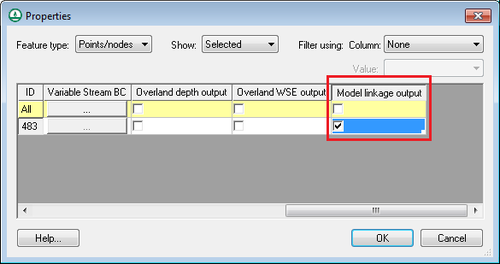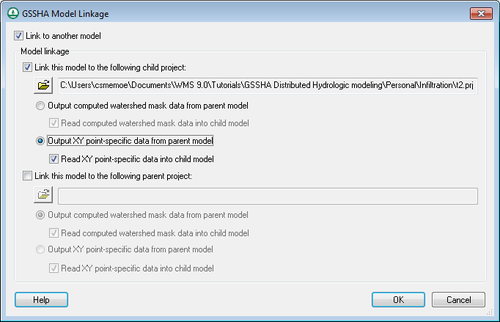WMS:GSSHA Model Linkage: Difference between revisions
(rm related in template) |
No edit summary |
||
| Line 1: | Line 1: | ||
[[File:WMS GSSHA Model Linkage dialog.png|thumb|right|380 px|''GSSHA Model Linkage'' dialog]] | |||
The ''GSSHA Model Linkage'' dialog, accessible from the ''GSSHA Job Control'' dialog, allows linking to current GSSHA model to other GSSHA models. If there is a parent (regional) model in the WMS interface and the user wants to link this parent model to a child (inset) model, select the options shown below: | The ''GSSHA Model Linkage'' dialog, accessible from the ''GSSHA Job Control'' dialog, allows linking to current GSSHA model to other GSSHA models. If there is a parent (regional) model in the WMS interface and the user wants to link this parent model to a child (inset) model, select the options shown below: | ||
Note that if these options are selected, WMS writes the appropriate cards to both the parent model and the child model, using the child model’s mask file as the output mask, so the boundary data is output from the parent model and is read into the child model. | Note that if these options are selected, WMS writes the appropriate cards to both the parent model and the child model, using the child model’s mask file as the output mask, so the boundary data is output from the parent model and is read into the child model. | ||
Revision as of 20:58, 15 May 2019
The GSSHA Model Linkage dialog, accessible from the GSSHA Job Control dialog, allows linking to current GSSHA model to other GSSHA models. If there is a parent (regional) model in the WMS interface and the user wants to link this parent model to a child (inset) model, select the options shown below:
Note that if these options are selected, WMS writes the appropriate cards to both the parent model and the child model, using the child model’s mask file as the output mask, so the boundary data is output from the parent model and is read into the child model.
If wanting to output data from the parent model at specific XY points, the user would define the point locations in the GSSHA coverage in the map module and mark these locations as Model linkage output points in the GSSHA point properties dialog, as shown below:
Then, select the option in the GSSHA Model Linkage dialog to output XY point-specific data from the parent model, as shown below:
In either case (whether using the mask option or the XY point option), it's necessary to define the name of the child project or the user will get an error when saving the project. If using the XY point option, the user will get an error when saving if in the GSSHA coverage there are no defined model linkage output points.
If there is a child model read into WMS and the user wants to define how it’s linked to a parent model, toggle the option to link the model to a parent project and define the appropriate options. Once again, it's necessary define a filename for the parent model.
A single model can also be used as both a parent and a child model but turning on both the link to child and the link to parent toggles in this dialog.
GSSHA | |
|---|---|
| XMS Wiki Links | Calibration (Automated • Manual • Output) • Channel Routing • Contaminants • Digital Dams • Embankment Arcs • Feature Objects (Arcs • Nodes • Polygons) • File Types • Groundwater • Groups • Hydraulic Structures • Job Control • Join SSURGO Data • Mapping Tables • Maps • Menu • Model Linkage • Multiple Simulations • Nutrients • Observations • Output Control • Overland Soil Erosion • Pipe and Node Parameters • Precipitation • Radar Rainfall • Save GSSHA Project File • Smooth GSSHA Streams • Snowmelt • Solution (Analysis • Data) |
| Related Tools | MWBM Wizard • Using Soil Type Data with GSSHA |
| GSSHA Wiki External Links | GSSHA Wiki: Overview • Primer • User's Manual • Tutorials |
WMS – Watershed Modeling System | ||
|---|---|---|
| Modules: | Terrain Data • Drainage • Map • Hydrologic Modeling • River • GIS • 2D Grid • 2D Scatter |  |
| Models: | CE-QUAL-W2 • GSSHA • HEC-1 • HEC-HMS • HEC-RAS • HSPF • MODRAT • NSS • OC Hydrograph • OC Rational • Rational • River Tools • Storm Drain • SMPDBK • SWMM • TR-20 • TR-55 | |
| Toolbars: | Modules • Macros • Units • Digitize • Static Tools • Dynamic Tools • Drawing • Get Data Tools | |
| Aquaveo | ||


